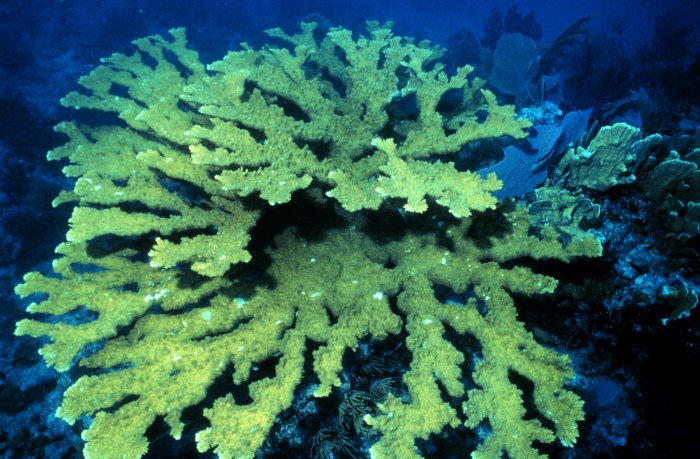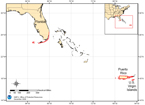Elkhorn Coral (Acropora palmata)

Elkhorn Coral
(Acropora palmata)
Photo: NOAA's Florida Keys National Marine Sanctuary

Elkhorn Coral Critical Habitat
(click for larger view PDF)

Elkhorn Coral Range Map
(click for larger image)

(Acropora palmata)
Photo: Andy Bruckner, NOAA

Elkhorn Coral
(Acropora palmata)
Photo: Andy Bruckner, NOAA

Elkhorn Coral
(Acropora palmata)
Photo: Jordan T. Wilkerson
Did You Know?
- Final recovery plan published in March 2015.
- Elkhorn coral, like many corals, receive most of their energy and oxygen from symbiotic organisms called zooxanthellae.
- Like counting rings in the trunk of a tree, the age of corals can be determined by examining coral growth rings.
CITES Appendix II - throughout its range
|
Length:
|
branches can grow to over 6.5 feet (2 m) |
|
Appearance:
|
their shape resembles elk antlers ("elk horn") |
|
Lifespan:
|
unknown |
|
Diet:
|
organic byproducts of photosynthesis; they may eat live prey, such as small fish and zooplankton, using their tentacles |
|
Behavior:
|
branched colonies of Acropora have exhibited competitive behavior, gradually extended over colonies of other corals, such as Montipora |
Elkhorn coral is a large, branching coral with thick and sturdy antler-like branches.
The dominant mode of reproduction for elkhorn coral is asexual, with new colonies forming when branches break off of a colony and reattach to the substrate. Sexual reproduction occurs via broadcast spawning of gametes into the water column once each year in August or September. Individual colonies are both male and female (simultaneous hermaphrodites) and will typically release millions of "gametes".
The coral larvae (planula) live in the plankton for several days until finding a suitable area to settle, but very few larvae survive to settle and metamorphose into new colonies. The preponderance of asexual reproduction in this species raises the possibility that genetic diversity may be very low in the remnant populations.
Colonies are fast growing: branches increase in length by 2-4 inches (5-10 cm) per year, with colonies reaching their maximum size in approximately 10-12 years. Over the last 10,000 years, elkhorn coral has been one of the three most important Caribbean corals contributing to reef growth and development and providing essential fish habitat.
Elkhorn coral was formerly the dominant species in shallow water (3 ft-16 ft (1-5 m) deep) throughout the Caribbean and on the Florida Reef Tract, forming extensive, densely aggregated thickets (stands) in areas of heavy surf. Coral colonies prefer exposed reef crest and fore reef environments in depths of less than 20 feet (6 m), although isolated corals may occur to depths of 65 feet (20 m).
Critical Habitat
NMFS designated critical habitat for elkhorn and staghorn corals in November 2008 in four areas:
- Florida
- Puerto Rico
- St. John/ St. Thomas
- St. Croix
Elkhorn coral is found on coral reefs in southern Florida, the Bahamas, and throughout the Caribbean. Its northern limit is Biscayne National Park, Florida, and it extends south to Venezuela, though it is not found in Bermuda.
Once found in continuous stands that extended along the front side of most coral reefs, the characteristic "Acropora palmata zone" supported a diverse assemblage of other invertebrates and fish. These zones have been largely transformed into rubble fields with few, isolated living colonies.
In areas where loss has been quantified, estimates are in the range of 90-95% reduction in abundance since 1980. Additional drastic reductions (around 75-90%) were recently observed in some areas such as the Florida Keys in 1998 due to bleaching and hurricane damage.- disease, such as white band disease
- hurricanes
- predation
- bleaching
- algae overgrowth
- sedimentation
- temperature and salinity variation
- low genetic diversity
Since 1980, populations have collapsed throughout their range from disease outbreaks with losses compounded locally by hurricanes, increased predation, bleaching, elevated temperatures, and other factors. This species is also particularly susceptible to damage from sedimentation.
The dominant mode of reproduction for elkhorn coral is asexual fragmentation; this life history trait allows rapid population recovery from physical disturbances such as storms. However, this mode of reproduction makes recovery from disease or bleaching episodes (in which entire colonies or even entire stands are killed) very difficult. The large role of asexual reproduction for this species increases the likelihood that genetic diversity in the remnant populations may be very low. Scientists are becoming increasingly concerned for this species based on its demographic paramaters; specifically, how species recruitment and genetic diversity affect recovery potential.
Florida Keys National Marine Sanctuary (FKNMS), the largest coral reef management entity in the region, has developed a management plan for the Sanctuary's corals that includes protective activities, such as zoning, channel markings, and restoration efforts.
Restoration activities have included efforts to re-attach Acropora fragments generated by ship groundings and hurricane events; these efforts have had mixed success. Similar efforts to re-attach coral fragments have also been made in Puerto Rico and the U.S. Virgin Islands.
Other restoration efforts have included attempts to culture and settle coral larvae with very limited success. New techniques for restoring Acropora are currently being pursued. Such new techniques involve enhancing sexual recruitment, reestablishing ecological roles within reef systems (e.g. herbivorous urchins), and other methods for controlling predators and disease.
In 1998, the United States Coral Reef Task Force was established by Presidential Executive Order 13089 to coordinate and strengthen efforts for protecting coral reef ecosystems. The Task Force is co-chaired by the Departments of Commerce and Interior, and includes leaders of 12 federal agencies, 7 U.S. states and territories, and 3 freely associated states. In 2002, the Task Force adopted a resolution calling for the development of Local Action Strategies, which are locally-driven plans for collaborative and cooperative action among federal, state, territory, and non-governmental partners to reduce key threats on valuable coral reef resources. Three Local Action Strategies have been developed within the range of elkhorn coral for Florida, Puerto Rico, and the U.S. Virgin Islands.On March 4, 2004, the Center for Biological Diversity ![]() petitioned NOAA's National Marine Fisheries Service (NMFS) to list elkhorn (Acropora palmata), staghorn (A. cervicornis), and fused-staghorn (A. prolifera) coral under the Endangered Species Act (ESA). On June 23, 2004, NMFS found that listing these species may be warranted [pdf] and initiated a formal review of their biological status. NMFS convened the Atlantic Acropora Biological Review Team (BRT) to summarize the best available scientific and commercial data available for these species in the status review report.
petitioned NOAA's National Marine Fisheries Service (NMFS) to list elkhorn (Acropora palmata), staghorn (A. cervicornis), and fused-staghorn (A. prolifera) coral under the Endangered Species Act (ESA). On June 23, 2004, NMFS found that listing these species may be warranted [pdf] and initiated a formal review of their biological status. NMFS convened the Atlantic Acropora Biological Review Team (BRT) to summarize the best available scientific and commercial data available for these species in the status review report.
The BRT completed the status review [pdf] [4.9 MB] on March 3, 2005. On March 18, 2005, NMFS determined that elkhorn and staghorn corals warrant listing [pdf] as "threatened" species under the ESA. However, NMFS also concluded that listing fused-staghorn coral is not warranted, as it is a hybrid and does not constitute a "species" as defined under the ESA. On May 9, 2005, NMFS proposed adding elkhorn and staghorn coral to the Endangered Species list [pdf].
NMFS finalized the ESA listing of elkhorn and staghorn coral on May 4, 2006 (71 FR 26852 [pdf]). More information can be found in the press release [pdf] of the final listing.
NMFS designated critical habitat for elkhorn and staghorn corals in November 2008.
In December 2012, NMFS proposed reclassifying (77 FR 73219) the elkhorn and staghorn corals as endangered, but determined in September 2014 that they would remain listed as threatened (79 FR 53852).
Kingdom: AnimaliaPhylum: Cnidaria
Class: Anthozoa
Order: Scleractinia
Family: Acroporidae
Genus: Acropora
Species: palmata (All documents are in PDF format.)
| Title | Federal Register | Date |
|---|---|---|
| Final Recovery Plan | 80 FR 12146 | 03/05/2015 |
| Final Listing Rule (reaffirms Threatened status) | 79 FR 53852 | 09/10/2014 |
| Draft Recovery Plan | 79 FR 53019 | 09/05/2014 |
|
Proposed Endangered Listing Rule |
77 FR 73219 | 12/07/2012 |
| Critical Habitat Designation | 73 FR 72210 | 11/26/2008 |
| Final 4(d) Rule | 73 FR 64264 | 10/29/2008 |
| Proposed Critical Habitat Designation | 73 FR 6895 | 02/06/2008 |
| Proposed 4(d) Rule | 72 FR 71102 | 12/14/2007 |
| ESA Listing Rule | 71 FR 26852 | 05/09/2006 |
| Proposed Threatened Listing Rule | 70 FR 24359 | 05/09/2005 |
| Status Review | n/a | 03/03/2005 |
| Proceedings of the Caribbean Acropora Workshop* | n/a | 04/2002 |
- Acropora Fact Sheet [pdf]
- Coral Research at NMFS Southeast Fisheries Science Center
- Coral Reef Habitat Conservation and Restoration
- NMFS Southeast Regional Office Acropora Information
- NOAA Coral Health and Monitoring Program
- NOAA Coral Reef Information System
- NOAA's National Marine Sanctuaries
- U.S. Coral Reef Task Force (USCRTF)
* Bruckner, A.W., 2002. Proceedings of the Caribbean Acropora Workshop: Potential Application of the U.S. Endangered Species Act as a Conservation Strategy. NOAA Technical Memorandum NMFS-OPR-24, Silver Spring, MD 199 pp.
Updated: March 5, 2015


